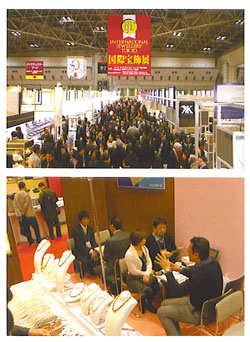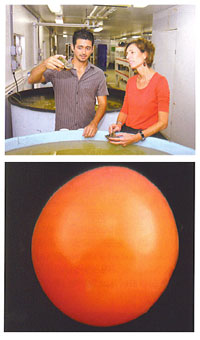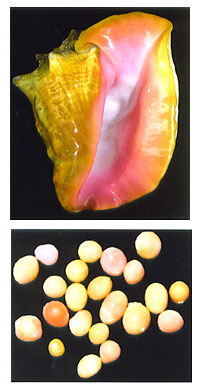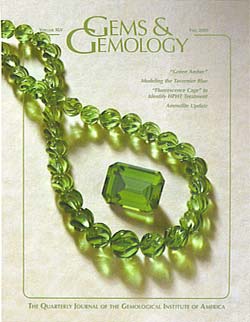| |
GIA
releases latest G & G - introduces new monthly electronic newsletter
for gemologists |
| |
The
Fall 2009 issue of the Gemological Institute of America’s (GIA}
Gems & Gemology (G&G} looks at a treated gem material being marketed
as "green amber," as wall as a new gemological test to detect
HPHT treatment in type I diamonds. It also offers a crystallographic analysis
of the Tavernier Blue diamond.
"Charactsrization
of 'Green Amber’ with lnfrared and Nuclear Magnetic Resonance Spectroscopy,"
by Dr. Ahmadjan Abduriyim and co-authors, provides a look at this material,
which is created by treating amber or its much younger counterpart, copal,
under heat and pressure.
"A
Crystallographic Analysis of the Tavernier Blue Diamond" by Scott
D. Sucher, builds on research to portray a more accurate model of this
historic diamond. In "‘Fluorescence Cage:' Visual Identification
of HPHT-Treated Type I Diamonds," Drs. Inga A. Dobrinets and Alexander
NI. Zaitsev review their discovery of a luminous network of fluorescence
at the facet edges and junctions of these treated diamonds. Other articles
cover ammolite production
in southern Alberta, Canada; polymer-filled aquamarine; the discovery
of yellow-green hauyne from Tanzania; and aquamarine from northern Italy.
|
|
|
| |
The
Lab Notes section features the latest discoveries from the GIA lab, including
a treated Fancy red diamond, and a useful technique to identify negative
crystals in ruby. Gem News International includes demantoid samples from
Madagascar, and new rubies from Mozambique.
G&G also recently introduced a new monthly electronic newsletter,
the "G&G eBrief" which delivers the latest research updates
to professional gemologists worldwide, who want brief articles on topics
that have immediate, practical application. Each G&G eBrief features
the latest findings from the GIA Lab, global news and trade alerts, helpful
tips, insight into future G&G issues, upcoming conferences, and exhibits
worldwide. The October through
December G&G eBriefs will be distributed free of charge. Beginning
in January 20l0, the newsletter will be available exclusively to G&G
subscribers. |
| |
|
| |
Pearl
Zone at IJT 2010 : World's best Collection of Pearls on Display |
| |
Of
all the exciting zones at IJT, the Pearl Zone especially continues
to draw great attention both domestically and worldwide. High quality
pearls of all kinds, sizes, shapes, luster, and prices will gather
under one roof at IJT, making this the best sourcing venue for pearls
in the start of the year.
Exhibits ot IJT 2010 [excerpts)
Only
the best quality pearls will gather at IJT, as Japen is the world’s
leading pearl producing country and only the highest quality is
accepted in this market. Pearl companies from all over Japan and
the world will proudly exhibit their lineup of competitive pearls
at IJT. Below are excerpts of especielly exceptional pearls to be
on display during the show:
Akoyo Pearls
You
can find the world’s top—class Akoya pearls, both as
finished jewellery or loose pearls.
Exotic Southsea Pearls
A
fine selection of high quality south sea pearls in black, white,
and gold will be aveilable to answer all your sourcing needs.
Freshwater Pearls
Freshwater
pearls enjoy a constant market in Japan, with especially a recent
growing need for those of especially high quality.
|
|
 |
|
| |
Pearls and
Gemstone Combinations
Exhibits
will include high-design jewellery that combines the elegance of pearls
with the glamour of diamonds, sapphires, and other gemstones.
Rare Keshi and Conch Pearls
Rare
and hard to find pearls such as those ot abalone, conch, and mabe pearls
will also be in the spotlight at lJT.
Free lnvitation Tickets!
International
Jewellery Tokyo (lJT) is Japan’s largest jewellery trade show, welcoming
1,350 exhibitors from 35 countries. Organised by Reed Exhibitions Japan
Ltd. and Japan Jewellery Association (JJA), IJT and its concurrent watch
show attracted 37,936 visitors from all
over the world last year. This is the leading venue to see a vast variety
ot products at wide price points and source for high quality and innovative
products. invitation tickets are available online at: www.ijt.jp/english/. |
| |
|
| |
Scientists
unlock the mystery of creating high-quality cultures pearls from the queen
conch |
| |
For
more than 25 years, all attempts at culturing pearls from the queen conch
(Strombus gigas) have been unsuccessful. Novv, for the first time, novel
and proprietary seeding techniques to produced beaded (nucleated) and
non-beaded cultured pearls from the queen conch have been developed by
scientists from Florida Atlantic University’s Harbor Branch Oceanographic
lnstitute (HBOl).
 |
|
With
less than tvvo years of research and experimentation, Drs.
Hector Acosta-Salmon and Megan Davis,co-inventors, have produced
more than 200 cultured pearls using the techniques they developed.
Prior to this break through, no high-quality queen conch pearl
had been cultured. This discovery opens up an opportunity
to introduce a nevv gem to the industry, HBOl says.
HBOl
has been vvorking with the Gemological Institute at America
(GIA) to conduct extensive lab testing at the queen conch
cultured pearls. ln its independent, analysis, GIA used techniques
that included conventional gemological examination, chemical
composition, spectroscopy, spectromstry, and microscopy.
"This
is a significant development for the pearl industry, and vve
vvere very excited to have the opportunity to closely examine
these uniques conch cultured pearls in our Iaboratory,"
said Tom Moses, senior vice president of the GIA Laboratory
and Research. "SeveraI of the pearls vve examined are
truly top-quaIity gems. With the eguipment and expertise available
at the GIA Laboratory, identification criteria are being compiled
to separate queen conch cultured pearls from their natural
counterparts." |
|
Previous
efforts to culture queen conch pearls vvere unsuccsssful. The
spiral snaps of the shell makes it virtually impossible to reach
the gonad, one of the pearl forming portions in pearl oysters,
without endangering the animaI’s Iife. "Perhaps the
most significant outcome from our research is that the techniques
vve have developed does not require sacrificing the conch in the
process," said Dr. Devis. "The 100 percent survival
rate of queen conch after seeding and the fact that it will produce
another pearl after the first pearl is harvested will make this
culturing process more efficient and environmentally sustainaple
for commercial application." Survival of the animal is critical
because
commercial fishing has depleted the once-abundant wild populations
of queen conch, and they are new considered a commercially threatened
species in Florida and throughout the Caribbean, HBOl said. |
There are basically two types of cultured pearls: nucleated
(beaded) and non-nucleated (non-beaeded). Nucleated cultured
pearls are preduced by inserting a piece of mentle tissue
from a dener moIlusk and a nucleus, usually a spherical
piece of shell, in to the body of a recipient mollusk. Nen-nucleated
pearls are produced by grafting only a piece or pieces of
mantle tissue, and no bead is inserted. "
"We used two different seeding techniques to induce
pearl Information in the queen conch," said Dr, Acosta-Salmon.
"One was a modification of the conventional technique
used to produce cultured pearls in freshwater mussels, and
the other was a modification of the conventional technique
used in marine pearl oysters."
Conch pearls are formed by concentric layers of fibrous
crystals, and this layering often produces the desired flame
structure, which is characteristic of conch pearls. The
pearls have a porcelain finish and luster like the interior
of the conch shell, and come in a wide variety
and combination of colors.
The size of the cultured pearls produced by Drs Acosta-Salmon
and Davis is controlled by the size of the bead and the
culture time. The researchers have experimented with culture
times from six months to two years; longer culture times
may produce larger pearls. The queen
conch is farmed in aquaculture tanks, and the queen conch
cultured pearls in the initial harvest were grovvn in an
aquaculture facility at HBOI. A Queen conch achieves full
size at about three years, and has a life span of up to
40 years.
www.hboi.fau.edu |
|
 |
| |
|
|
|
|





